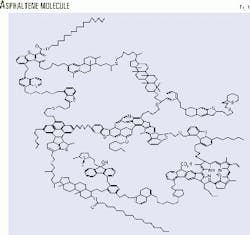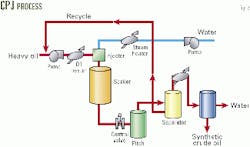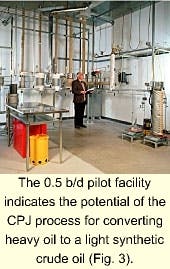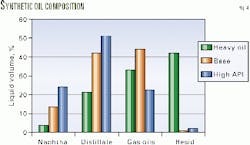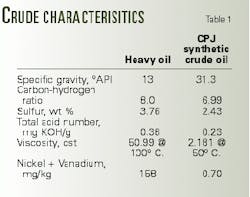Production site heavy-oil upgrader shows promise
Pilot tests of a new heavy oil-upgrading technology show promise either for production site or refinery installation, according to its developer Carbon Resources Ltd., a subsidiary of Synergy Technologies Corp., both of Calgary.
Carbon Resources has acquired and tested the upgrading technology that converts heavy petroleum fractions to more-valuable, higher API-gravity oils.
It says the process, called CPJ after its inventor, Pierre Jorgensen, can be applied to field upgrading of bitumen, heavy oils, atmospheric tower bottoms, and vacuum tower bottoms. Developed in France, Carbon Resources says the French patent has been granted and US and appropriate international patents are pending.
It has tested the CPJ process on Alberta bitumen and heavy oils as low as 7.5° API and has produced 30°+ API gravity synthetic crude oil, with liquid volume yields exceeding 90%. The CPJ process uses no hydrogen and no catalyst.
The CPJ process has the advantage of letting the operator adjust process conditions to optimize the middle-distillate fractions relative to the vacuum gas oils to suit the refiner, according to the company.
Heavy oil
Bitumen is often classified to be in the 5-10° API range, whereas heavy oil falls in the 10-20° API range. Refinery atmospheric tower bottoms and vacuum-tower bottoms also fall into these categories. These petroleum streams have one thing in common: huge molecules having molecular weights in excess of 2000, like the asphaltene molecule shown in Fig. 1.
To convert these streams to lighter, more-desirable petroleum fractions, one needs to break these huge molecules.
The large reserves of bitumen and heavy oil in the world are difficult and expensive to produce. In addition, these resources have high asphaltene and resid content that make them undesirable as general refinery feedstocks.
To maximize the recovery of this abundant resource, therefore, the bitumen and heavy oil must be upgraded near its source into a lighter, more-desirable synthetic crude oil.
Carbon Resources believes upgrading facilities ranging in capacity from 5,000 to 25,000 b/d will fit the requirement of most producers.
CPJ process
Carbon Resources describes the underlying principle of the CPJ process (Fig. 2) as one that applies an instantaneous thermal shock to the asphaltene molecule using superheated steam. The bitumen or heavy oil feedstock is preheated to near its thermal-cracking point and contacted with superheated steam in a proprietary injector where most of the reaction takes place. Contact time is a matter of seconds.
The hot reactants then are allowed to stabilize in a soaker vessel, which has no internals, for a short time. Soaker effluent is then flashed through the control valve to a separator where the pitch is drawn off and used as fuel.
Overhead from this separator is cooled and flowed to another flash tank where the vacuum gas oil fraction is drawn off and pumped back to the reactor for additional upgrading. The overhead stream is further cooled, the condensed water is drawn off, and the upgraded synthetic crude is pumped to storage tanks. Carbon Resources says the CPJ process does not require vacuum separation.
Fig. 3 shows Carbon Resources' CPJ 0.5-b/d pilot facility in Calgary. Carbon Resources indicates that the CPJ process is unique for the following reasons:
- The process can produce a synthetic crude oil with yields in excess of 90% liquid volume with API gravities modulated to suit the refiner.
- The nature of the process is to cause the huge molecules to break almost in half, producing very little soot and gas.
- The process requires no catalyst or hydrogen.
Fig. 4 indicates that the CPJ process offers flexibility to produce a synthetic crude oil composition to suit the refiner. The figure compares heavy-oil composition with two cases:
- In the base case, with a 27.2° API synthetic crude oil, the resid content of the heavy oil is reduced to near zero, 0.5% liquid volume from 41.8% liquid volume, and the distillate to gas oils ratio increases from 0.64 to 0.96.
- In the high-API case, a stream, chiefly consisting of heavy vacuum gas oil, 46% liquid volume, is recycled back to the CPJ reactor in which a 31.3° API synthetic crude oil is produced having a 2.24 distillate to gas-oil ratio.
Carbon Resources says the CPJ process can even be operated in such a manner to produce synthetic crude oil having no atmospheric bottoms.
The National Centre for Upgrading Technology (NCUT), near Edmonton, analyzed the samples for Carbon Resources. Table 1 lists some of the characteristics of the high-API synthetic crude oil and the feed-stock heavy oil.
Carbon Resources notes the mass balances show that not only is the carbon-hydrogen ratio increased in the synthetic crude oil relative to the heavy oil, but also that the hydrogen content is increased by about 10%, total outlet vs. inlet balance, by the CPJ process.
Economics
Carbon Resources estimates that capital costs for a nominal 20,000 b/d feed CPJ facility are in the $4,000/bbl range. These costs are for a "greenfield" site including sulfur removal from the produced gas and process-water treating. Operating costs, which include labor, maintenance, and power ($0.05/kw-hr) are in the $1.04/bbl range.
It says the pitch is nominally more than enough to supply fuel required for the CPJ process and, coupled with the off gas, can be a source of export fuel to a steam-assisted gravity drainage (SAGD) or other bitumen-heavy oil production technique.
Both capital and operating expenditures can be reduced by combining the CPJ process with other process units in a refinery or a bitumen-heavy oil production facility such as a SAGD site, according to Carbon Resources.

